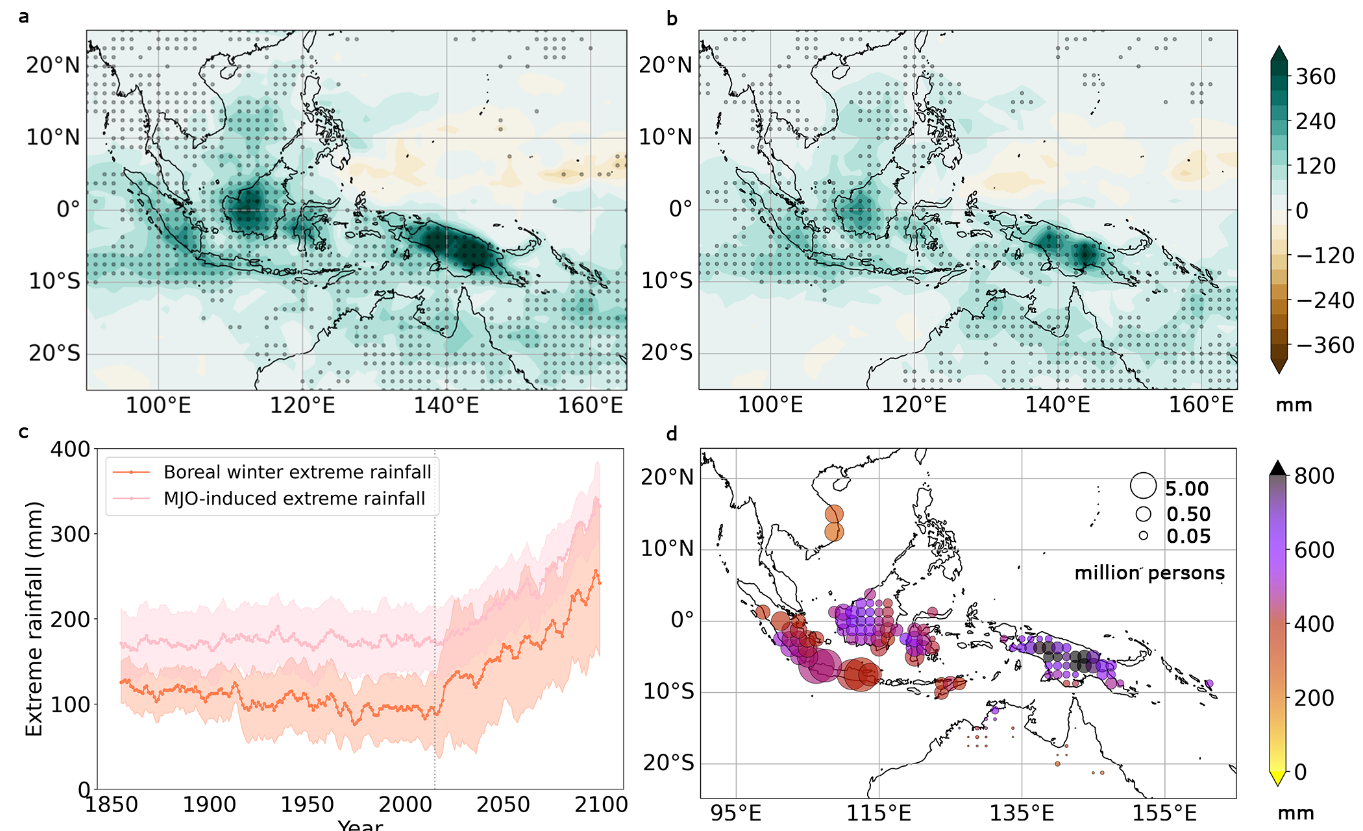Researchers publish new results in field of global warming and Madden-Julian Oscillation-induced extreme rainfall
The sixth assessment report of the IPCC indicates low-to-high confidence in trends of extreme rainfall with regional inconsistency in the tropics, where a key phenomenon causing intra-seasonal variations in weather is the Madden–Julian Oscillation (MJO). MJO is the several-thousand-km envelope of clouds, winds, and rainfall that moves eastwards along the equator with a 20–90 day timescale during the boreal winter season, triggering extreme rainfall over tropical Asia and northern Australia.
Many studies have made projections on changes in MJO activity in a warming climate via Earth System Models (ESMs). Still, it remains unclear how changes in MJO-induced extreme rainfall may influence societal exposure in response to future warming and climate mitigation attempts. Such efforts rely on accurate simulation of MJO processes in ESMs. However, most CMIP5 models largely underestimate MJO amplitude and fail to reproduce a coherent eastward propagation of MJO. Recently, some CMIP6 ESMs have demonstrated substantial improvements in simulating the structure of MJO. These model advances create an opportunity to address the dynamics of MJO-related extreme rainfall and its potential socio-economic consequences in the coming decades.

Associate Professor Zhenzhong Zeng’s team from the School of Environmental Science and Engineering at the Southern University of Science and Technology (SUSTech) has recently published their findings where they evaluate the model outputs from the Coupled Model Intercomparison Project Phase 6 to project the changes of MJO-induced extreme rainfall and the associated societal exposure in response to future warming and climate mitigation attempts at the end of the 21st century.
Their research, entitled “Madden-Julian Oscillation-induced extreme rainfalls constrained by global warming mitigation,” was published in npj Climate and Atmospheric Science, a journal by Nature covering the relevant physical, chemical, and biological components of atmospheric and climate science.

Figure 1. Spatiotemporal changes of multi-model mean boreal winter extreme rainfall under the SSP5-8.5 scenario. Spatial distribution of the changes in boreal winter extreme rainfall amount (a) and MJO-induced extreme rainfall amount (b) between the future period (2079–2099) and the present period (2015–2035) under the SSP5-8.5 scenario over the study area. Stippling denotes where the multi-model mean changes exceed the inter-model variance. c) Temporal series of the boreal winter extreme rainfall and MJO-induced extreme rainfall over the land areas within 25°S–20°N, 95°E–155°E during 1855-2099. Values are smoothed through the 5-year running mean. Shadings refer to half of the inter-model spread. d) Exposure map of population to the projected increases of future MJO-induced extreme rainfall. The future MJOinduced extreme rainfall is the simulated increments between the future (2079–2099) and present (2015–2035) periods added up to the historical period (1994–2014). The size of the circles represents the amount of exposed population, while the color shows the MJO-induced extreme rainfall amount.
The researchers detect a nearly 60% increase in extreme rainfall over tropical Asia and Australia by the end of the 21st century under the fossil-fueled warming scenario (SSP5-8.5); 84% of this change is associated with MJO-induced extreme rainfall. The regions that are most likely to be affected include Malaysia, Indonesia, and northern Australia, where 96.68 million people and 9.72 million km2 of urban areas are exposed to potential danger stemming from extreme rainfall. More than 95% (99%) of the population (urban) exposure can be potentially avoided under the “middle of the road” development (SSP2-4.5) scenario, whereby CO2 emissions hover around current levels before starting to fall mid-century.
Shijing Liang, a master’s student in the School of Environmental Science and Engineering at SUSTech, is the first author of this paper. Research Asst. Prof.Dashan Wang and Assoc.Prof.Zhenzhong Zeng from SUSTech are the corresponding authors. Cooperating members include Prof. Alan D. Ziegler of MaeJo University (MJU) and Prof. Laurent Z. X. Li of Laboratoire de Météorologie Dynamique (LMD).
This study was supported by the National Natural Science Foundation of China (NSFC), the Start-Up Fund provided by SUSTech, and the China Postdoctoral Science Foundation.
Paper link: https://www.nature.com/articles/s41612-022-00291-1
